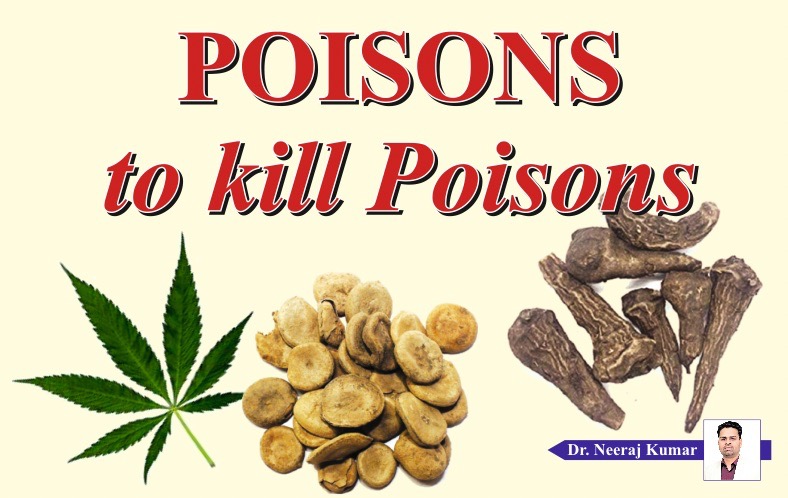Ayurveda, being a science of life, is dedicated to cure the disease with natural ways viz herbs, minerals and yoga. The ancient texts have mentioned many herbs which are considered toxic, if not purified and consumed properly, and not taken under physician’s guidance. Some of these are vatsnabh, dhatura, kuchla, bhanga and arka.
Ayurveda, being a science of life, is dedicated to cure the disease with natural ways viz herbs, minerals and yoga. The ancient texts have mentioned many herbs which are considered toxic, if not purified and consumed properly, and not taken under physician’s guidance. Some of these are vatsnabh, dhatura, kuchla, bhanga and arka. These are used very commonly in ayurvedic formulations and have miraculous effects. These herbs have been in use since ages in ayurveda after proper detoxification and refinement and this process is known as Shodhana. This process of purification not only decreases the toxicity of these herbs but also increases their therapeutic efficacy. There are various processes for purification such as putting herbs in a liquid, boiling them in medicated liquid and frying in cow ghee. In most of these processes cow milk, cow urine and citrus juices are commonly used. Sometimes this whole process of detoxification may involve more than one process mentioned above and is applied multiple times for making these herbs fit to be used in drug formulations.
Now the question arises if these herbs are so toxic, what is the need to use them. The answer lies in the concepts of ayurveda mentioned in ancient scriptures which explain that these herbs have properties like light, dry, quick in action, vivid, sharpness, fast absorbing and subtle, but using them without subjecting to purification process may result in unwanted effects.
LIST OF HERBS
Vatsnabha (Aconitum Ferox)
Also known as “meetha visha” because of its palatable taste, it is purified with of cow’s urine or milk, with no boundaries. Known to be one of the most potent rasayanas (rejuvenators) it can be used as a strengthening agent for the body. It works in inflammatory conditions associated with skin, scalp, respiratory, and gastric system. Its effects are also seen in rheumatic conditions and gout where it is predominantly used in pain management.
2. Kuchla (Strychnos nux vomica)
Seeds of this plant are used in many herbal formulations. The fine powder of the seeds is used to increase appetite and helps in digestion. Because of its properties to excite nervous system, it is used in the treatment of facial paralysis, paraplegia and painful disorders. The powdered seeds are also used as aphrodisiac.
3. Dhatura (Dhatura metel)
Beneficial parts of this plant are seeds, flowers, leaves and root. It is mainly used for its analgesic effect and antipyretic effect. Topical application of the powder of roots in hair loss and acne is also mentioned.
4. Bhanga (Cannabis sativa)
Parts used are leaves and fruit. It is used as an analgesic in ayurveda. In small quantities, it increases appetite and helps in digestion. It slows down gastric motility, so it is very effective in non-infective diarrhoea and severe dysentery. Topical application of the paste of leaves in piles relieves pain temporarily. In smaller doses, it also helps in insomnia.
5. Arka (Calotropis procera)
The decoction made with leaves helps in skin disorders, when used internally. Concentrated juice extracted from the soft leaves of this plant is used in respiratory illness. In ayurveda, the milk exudate of this plant is found useful in scorpion bite. The medicine prepared with the snuhi and arka milk with oil is used as local application for quick healing of chronic wounds.
Given above are the therapeutic uses of some of the plants mentioned in ayurvedic texts under the category of toxic plants. Ancient scholars had so much knowledge about the properties and potency of these herbs that they developed the scientific and efficient methods to use them for serving mankind. These herbs can help in the treatment of various chronic diseases and even prolong the average life expectancy if used as rasayana by an otherwise healthy individual. These herbs are used only when the regular low potency drugs fail to produce required results. The medicines prepared from these herbs are to be used only under the expert guidance of a registered ayurveda practitioner and not merely by reading or listening.
Assistant Professor
Dr. Neeraj Kumar
Department of Agad Tantra
Dayanand Ayurvedic College,
Mahatma Hansraj Marg, Jalandhar-8
Mob.: 98163 89994







 Dec 2024
Dec 2024
 May 2024
May 2024
 September 2022
September 2022
 April 2022
April 2022
 October 2020
October 2020
 Jan 2020
Jan 2020
 June 2019
June 2019
 January-February 2019
January-February 2019
 Augest-September
Augest-September
 April 2018
April 2018
 November 2017
November 2017
 June 2017
June 2017
 November 2016
November 2016
 September 2015
September 2015
 March 2015
March 2015
 July 2014
July 2014
 January 2014
January 2014
 July2013
July2013
 March 2013
March 2013
 May 2012
May 2012
 May 2011
May 2011
 Sep 2010
Sep 2010
 Jun 2010
Jun 2010
 Feb 2010
Feb 2010
 December 2009
December 2009
 August 2009
August 2009
 June 2009
June 2009
 Feb 2009
Feb 2009
 December 2008
December 2008
 October 2008
October 2008
 March 2008
March 2008
 July 2008
July 2008
 May 2008
May 2008